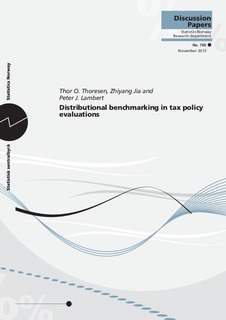| dc.contributor.author | Thoresen, Thor Olav | |
| dc.contributor.author | Jia, Zhiyang | |
| dc.contributor.author | Lambert, Peter J. | |
| dc.coverage.spatial | Norway | nb_NO |
| dc.date.accessioned | 2019-11-12T09:51:15Z | |
| dc.date.available | 2019-11-12T09:51:15Z | |
| dc.date.issued | 2013-11 | |
| dc.identifier.issn | 0809-733X | |
| dc.identifier.uri | http://hdl.handle.net/11250/2627880 | |
| dc.description.abstract | Given an objective to exploit cross-sectional micro data to evaluate the distributional effects of tax policies over a time period, the practitioner of public economics will find that the relevant literature offers a wide variety of empirical approaches. For example, studies vary with respect to the definition of individual well-being and to what extent explicit benchmarking techniques are utilized to describe policy effects. The present paper shows how the concept of distributional benchmarking can be exploited to describe methodological options for the tax policy analyst. We present classifications of the various approaches which can be found in the literature for evaluations of individual taxation along these lines, and provide empirical illustrations and interpretations for the case of the personal income tax schedule of Norway for the period 2000–2010. | nb_NO |
| dc.language.iso | eng | nb_NO |
| dc.publisher | Statistisk sentralbyrå | nb_NO |
| dc.relation.ispartofseries | Discussion papers;765 | |
| dc.subject | JEL classification: H23 | nb_NO |
| dc.subject | JEL classification: H24 | nb_NO |
| dc.subject | JEL classification: I31 | nb_NO |
| dc.subject | JEL classification: J22 | nb_NO |
| dc.title | Distributional benchmarking in tax policy evaluations | nb_NO |
| dc.type | Working paper | nb_NO |
| dc.description.version | publishedVersion | nb_NO |
| dc.subject.nsi | VDP::Matematikk og Naturvitenskap: 400::Matematikk: 410::Statistikk: 412 | nb_NO |
| dc.source.pagenumber | 29 | nb_NO |
